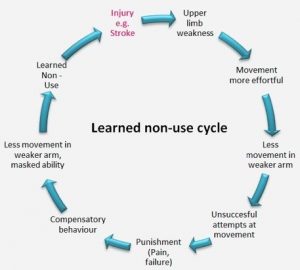Home Page
FES Device for the Reaching Movements in Patients with Post-Stroke Upper Extremity Hemiparesis
Strokes are one of the leading causes of disability in the United States. About 650,000 Americans survive a stroke yearly and 7 million Americans are living with the complications [3]. Due to this brain damage, an individual’s motor functions are often negatively affected as a result. About 75% of post-stroke patients experience upper extremity impairments that interfere heavily with activities of daily living
Hemiparesis results in the functional loss of upper-limb motor control in post-stroke patients. The reaching movement is often limited and prevents completion of daily tasks. These hemiparetic patients will attempt to use these impaired limbs, but to no avail. After many unsuccessful attempts, they will simply learn to perform their daily activities without using the impaired limb. This negative cycle of use is called the “learned non-use cycle,” illustrated in the figure below. Our team is trying to reverse this negative cycle into a positive cycle of use.

This can be done by assisting the post stroke hemiparetic patients in the reaching movement. The reaching movement mainly consists of the triceps, biceps, and the deltoids. The triceps shall be stimulated to initiate extension of the arm. Thus, the movement due to stimulation was studied in one plane of movement; the horizontal plane (X-Y axis).
